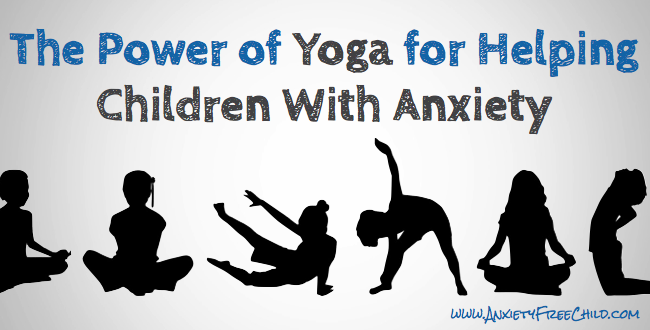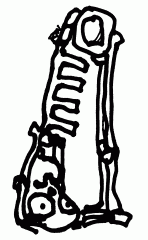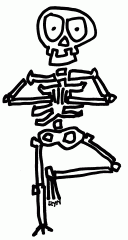 Yoga can make your anxious child into a dog, a mountain or tree, but the best benefit of all may be in reducing his or her anxiety. Don’t worry – neither of you have to chant, pray or wear strange outfits. And you won’t suddenly become a hippie or a Hindu. Yoga is big enough to be open to all and amazing enough to benefit many.
Yoga can make your anxious child into a dog, a mountain or tree, but the best benefit of all may be in reducing his or her anxiety. Don’t worry – neither of you have to chant, pray or wear strange outfits. And you won’t suddenly become a hippie or a Hindu. Yoga is big enough to be open to all and amazing enough to benefit many.
What is Yoga?
Yoga consists of a series of exercises meant to promote harmony and overall well-being. The practice originated more than 3,000 years ago in India and has been increasingly making its way into the modern Western world. It had a heyday in the 1970s, then petered out and is now back helping people of all ages look better, think better and feel better.
The word “yoga” comes from the Sanskrit word to “yoke.” The practice is thus meant to unite the body, mind and spirit. Yoga achieves this unification with a series of yoga poses, also called asanas, as well as through deep breathing, calm thinking and an acute awareness of the world around us. A regular practice not only unifies the body, mind and spirit but also produces benefits for all three. If you and your child start a regular yoga practice, you may note your body becomes more flexible, your mind becomes clearer and your spirit may become calmer.
Even a single yoga session has been shown to alleviate anxiety and stress. While many different types of yoga exist, they all aim to achieve a calm balance of body, mind and spirit. Yoga incorporates many of the techniques we’ve discussed in previous posts for anxious children.
Yoga’s diaphragmatic breathing involves breathing deep into the belly and exhaling just as deeply. We discuss it at length in our post Teaching Your Anxious Child to Calm Themselves with Their Breath. Achieving balance in the poses takes concentration and awareness, or mindfulness, which we discuss in greater depth in our Parents Guide to Teaching Mindfulness to Children with Anxiety.
Yoga seamlessly incorporates all these things into a single practice, giving you and your anxious child a kind of one-stop shop for serenity. Don’t be dissuaded by the myths, either, as the only thing you both need to practice yoga is a willingness to give it a whirl.
Yoga Myths
It’s religious. There are no gods you must bow to, no prayers to recite and no religious beliefs you must embrace. Yoga is not a religious practice and need not be linked to any religion. While the foundations of what we practice as yoga originally came from Hindu theistic philosophy, the practice of it is open to all denominations, backgrounds and beliefs. If you want to learn more about yoga’s origins and myths, good for you! If you don’t, then don’t. You and your anxious child can still benefit from the physical exercise, the breathing techniques and the mental well-being that come from a regular yoga practice.
You have to be a certain age of fitness level. No and no. As long as someone is old enough to understand how to attempt a pose, he or she is old enough to try it. And as long as someone is willing to attempt a pose, he or she is also fit enough to try it. While you may have seen some amazing yogis in some equally amazing poses, those poses have most likely been attained through years of practice. Just because you can’t throw like a pro baseball player doesn’t mean you can’t play catch with your child, now, does it?
As with anything, the more you practice the more flexible and adept you will be. Yoga poses are designed to accommodate all fitness levels, with a host of very simple poses and the ability to tailor more difficult poses to fit individual needs. Can’t yet balance on one leg? Try using a wall for stability until you get it. Can’t full touch your toes in standing bend? Try touching your knees until you get it.
You need gads of expensive equipment and clothing. While your child may certainly look adorable in a full-fledged yoga outfit, the only equipment you really need is a sturdy yoga mat. And even that can be optional provided you have a not-so-hard floor that provides enough traction so you or your child won’t slip. Soft socks on a hardwood floor won’t cut it, but bare feet on a rubber mat will. As for the clothing, it can be anything that is comfortable enough to let you and your child move freely without binding or getting in the way. Sweats and a T-shirt are perfectly fine.
How Yoga Works
Yoga is such an effective practice for anxious children because it soothes their mind which, in turn, soothes the body’s stress response. Yoga can very quickly alleviate the feelings of anxiety and stress in the mind, which gives the body the signal to slow down all the physiological arousals. That means the calmed-down mind translates to a calmed-down breathing pattern, a slower heart rate and lower blood pressure.
Studies noted by Harvard Health Publications showed yoga to be an effective tool for alleviating anxiety, depression, post-traumatic stress disorder and even bipolar disorder and schizophrenia. Additional research gave yoga a thumbs-up for enhancing the quality of life and overall mood for breast cancer survivors, people suffering from epilepsy, the elderly and people caring for those afflicted with dementia.
With a line-up like that, you can pretty much bet yoga can also help your anxious child.
Evidence of Yoga Working
A study published in Medical Science Monitor checked out the effects of yoga on women who admitted to being “emotionally distressed.” The women were divided into two groups. One group engaged in two yoga classes per week for a three-month period while the other did not engage in any stress-reduction activities.
At the end of the three months, the women who had practiced yoga said they had lower levels of anxiety, stress, depression and fatigue and higher levels of energy. They also noted an improvement in their overall well-being. In addition to their mental enhancements, the yoga-practicing women also reported a decrease in physical ailments such as back pain and headaches. One more benefit? The yoga group found their quality of sleep had also improved.
Another study, this one published Psychiatric Rehabilitation Journal, took yoga to a psychiatric hospital. It examined the effects of yoga on 113 patients with diagnoses such as major depression, bipolar disorder and schizophrenia. After a single yoga class, patients reported a significant decrease in anxiety, tension, depression, hostility, anger and fatigue. Patients were given the option of participating in additional yoga classes, and those who did found similar relief after each session.
People who respond poorly to stress are also more likely to have low thresholds for pain, and research presented at Los Angeles’ International Association of Yoga Therapists Symposium on Yoga Therapy and Research found yoga can help both.
The study looked at MRIs from three groups of individuals: those suffering from the painful, chronic condition of fibromyalgia, those who regularly practiced yoga, and a control group that neither practiced yoga nor suffered from medical conditions such as fibromyalgia.
A comparison of three groups’ responses to pain found the people suffering from fibromyalgia had the highest sensitivity to pain while the yoga group had the lowest sensitivity. Likewise, MRI readings of the fibromyalgia group showed the greatest activity in brain areas associated with pain responses while the yoga group had the least amount of brain activity in those areas. The third group fell in the middle for both brain activity and pain sensitivity.
“The study underscores the value of techniques, such as yoga, that can help a person regulate their stress and, therefore, pain responses,” Harvard Health Publications says.
Tips for Helping Anxious Children Practice Yoga
Play up the pose names. Yoga poses have the benefit of being named for an animal or object that they supposedly resemble. While some, like the cow’s head pose, may take a bit of imagination to figure out how the pose is supposed to look like its name, others are very obvious. Take advantage of the names to have your anxious child not only practice the pose but to become that specific animal or object.
During tree pose, for instance, tell your child to stretch his or her arms long and tall like the branches of a tree. Encourage your child to make a “ruff” noise when he or she exhales while doing downward facing dog.
Highlight the breath. Breathing is an integral part of yoga, and you can make that obvious if you include noises, like the downward facing dog’s “ruff,” when your child exhales. Exhale in the tree pose with a swishing noise like the wind in the leaves. Exhale during mountain pose while making a deep noise like the echo of a majestic mountain. You get the idea. Paying such acute attention to breath can help ensure your child remembers to breathe. And the breathing will be deep and full since it takes a lot of air to produce the best ruffs, swishes and echoes!
Make it fun. You probably already get the gist that yoga does not have to be a serious and solemn practice. The more fun you make it, the more eager your child will be to engage in it. You can add another layer of fun by supplementing your child’s yoga practice with guides or books that add a bit of humor to the practice, such as Ryn Gargulinski’s Bony Yoga. This book has been effectively used in classrooms for lessons in yoga as well as art.
Below are a few of the cartoon illustrations from the book to offer examples of poses you and your anxious child can try. Check out the rest of Bony Yoga on Amazon.com.
Yoga Poses for Your Anxious Child
 Mountain pose. You and your child stand with your legs shoulder-width apart, your back straight, your shoulders back and your arms down by your sides. Take a deep inhale and swoop your arms up to your sides then over your head, keeping your arms straight and your fingertips pointed at the ceiling. Keep your arms up, with palms facing each other and deeply exhale like the echo of a mountain. Inhale again and exhale, swooping your arms back down to your sides.
Mountain pose. You and your child stand with your legs shoulder-width apart, your back straight, your shoulders back and your arms down by your sides. Take a deep inhale and swoop your arms up to your sides then over your head, keeping your arms straight and your fingertips pointed at the ceiling. Keep your arms up, with palms facing each other and deeply exhale like the echo of a mountain. Inhale again and exhale, swooping your arms back down to your sides.
Standing forward bend. Start in mountain pose and inhale to swoop your arms above your head. You are going to  exhale and make the mountain noise, but instead of swooping your arms back down to your sides, bend your body in half from the waist and swoop your fingertips toward the floor. Inhale and exhale while bent over, letting the top half of your body go limp like a rag doll. Inhale again and swoop back up into mountain pose with your arms above your head, then exhale to swoop your arms down to your sides.
exhale and make the mountain noise, but instead of swooping your arms back down to your sides, bend your body in half from the waist and swoop your fingertips toward the floor. Inhale and exhale while bent over, letting the top half of your body go limp like a rag doll. Inhale again and swoop back up into mountain pose with your arms above your head, then exhale to swoop your arms down to your sides.
 Tree pose. Stand in mountain pose with your arms at your sides. Inhale and lift your left leg slightly with the knee bent to the side and place the bottom of your left foot on the inside of your right knee. Place your palms together in front of your breast bone. Exhale and make the swishing leaves noise, holding the pose. Inhale again, then exhale and swoop back down to mountain pose with our arms down by your sides. Repeat the pose balancing on your other leg.
Tree pose. Stand in mountain pose with your arms at your sides. Inhale and lift your left leg slightly with the knee bent to the side and place the bottom of your left foot on the inside of your right knee. Place your palms together in front of your breast bone. Exhale and make the swishing leaves noise, holding the pose. Inhale again, then exhale and swoop back down to mountain pose with our arms down by your sides. Repeat the pose balancing on your other leg.
Downward Facing Dog. You and your child get on all fours on the mat, with your knees bent and your palms flat, fingers facing forward, and directly below your shoulders. Inhale deeply, hold, then exhale as you press the bottoms of your toes on the mat behind you and extend your legs. Your rear should be up in the air, your back straight and your arms and legs extended. Inhale deeply and deeply exhale, making that “ruff” sound you’ve all been waiting for!
SOURCES:
- http://www.health.harvard.edu/newsletters/Harvard_Mental_Health_Letter/2009/April/Yoga-for-anxiety-and-depression
- http://kidshealth.org/teen/food_fitness/exercise/yoga.html
- http://www.namastekid.com/learn/kids-yoga-poses
- http://www.parents.com/fun/activities/indoor/yoga-for-kids
- http://www.mindbodygreen.com/0-1007/5-Great-Yoga-Poses-for-Kids.html
- http://www.ncbi.nlm.nih.gov/pubmed/16319785
- http://www.ncbi.nlm.nih.gov/pubmed/15895926
Study info:
- Michalsen A, et al. “Rapid Stress Reduction and Anxiolysis Among Distressed Women as a Consequence of a Three-Month Intensive Yoga Program,” Medical Science Monitor (Dec. 2005): Vol. 11, No. 12, pp. CR555–61.
- Lavey R, et al. “The Effects of Yoga on Mood in Psychiatric Inpatients,” Psychiatric Rehabilitation Journal(Spring 2005): Vol. 28, No. 4, pp. 399–402.
- Bradshaw DH, et al. “Psychophysiological and fMRI Indicators of Stress Response in Fibromyalgia Patients, Yoga Practitioners, and Healthy Volunteers,” poster presentation, International Association of Yoga Therapists Symposium on Yoga Therapy and Research, Los Angeles, March 2008.





